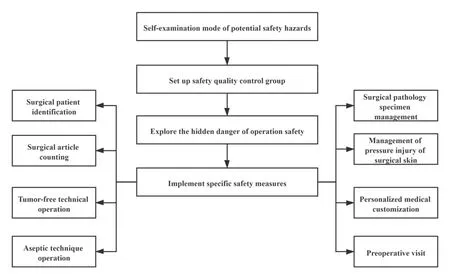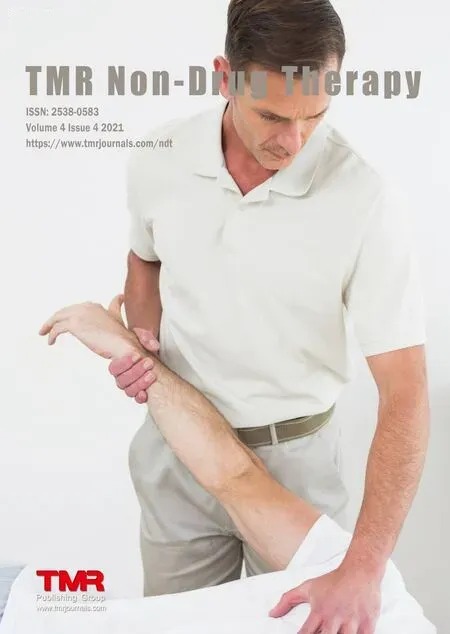Application effect of safety hazard selfexamination mode in nursing risk management in hepatobiliary surgery
Yong-Chao He, Chen Pan, Xue Song, Xiao Zhang, Hong-Xu Ren, Teng Sun, and Xiao-Yu Liu
Abstract—Objective: To explore the application effect of safety hazard self-examination mode in nursing risk management in hepatobiliary surgery.Methods: Sixty patients underwent hepatobiliary surgery in two tertiary hospitals in Shandong Province from May 2021 to October 2021.According to the different implementation time, they were divided into 30 cases in the observation group and 30 cases in the control group.The control group adopts routine risk assessment, and the observation group adopts the selfexamination mode of potential safety hazards on the basis of routine risk assessment to compare the incidence of nursing risk between the two groups.Results: The observation group had a significantly lower incidence of safety hazards in terms of missing surgical instruments, lack of aseptic operation, and postoperative pressure injuries than the control group (P <0.05).Conclusion: The appropriate hazard self-examination mode in the hepatobiliary operation room is of positive significance to improve the safety awareness of operating staff and the comprehensive ability of operating room nurses.
Key words—Safety hazard self-examination mode,Hepatobiliary surgery, Operating room, Risk management
INTRODUCTION
Hepatobiliary surgery plays an important role in all kinds of surgery, because it involves many organs,complex disease spectrum, many surgical methods,coupled with the patient condition varies from person to person, lead to different surgery, for intraoperative difficult prediction may be inaccurate, easy to increase safety risks and risk rate, delay the operation progress, and it is also prone to nosocomial infection and pain after surgery [1].In order to reduce the occurrence of nursing risks, surgical participants should take the initiative to find safety hazards,sum up their own experience, to reduce and avoid risks,and improve the safety of patients and surgery.[2].
CLINICAL DATA AND METHODS
General Information
A total of 60 patients undergoing hepatobiliary surgery in two Grade III and Grade A hospitals in the medical system of Shandong Province from May 2020 to October 2020 were selected as the research subjects.There were 30 cases in the observation group, age 35.6 ± 3.2 years old,disease type: 10 cases of cholecystectomy; 8 cases of biliary stone removal; 5 cases of liver cancer; 3 cases of pancreatic head cancer; 4 cases of liver cyst fenestration.There were 30 cases in the control group, age 35.2 ± 3.5 years old, disease type: 9 cases of cholecystectomy; 10 cases of biliary stone removal; 3 cases of liver cancer; 4 cases of pancreatic head cancer; 3 cases of hepatic cyst fenestration.There was no statistically significant difference between the two groups (P> 0.05)
Research technique
The control group carries out risk care according to the standard requirements according to the operating room nursing guide.The observation group adopts the selfexamination mode of safety hazards on the basis of routine risk assessment.The specific measures are as follows(Figure 1).

Figure 1 Flow chart of self-inspection mode of potential safety hazard
Establish a safety and quality control groupIt is composed of 1 team leader of hepatobiliary surgery and 5 specialist nurses of hepatobiliary surgery.Through lectures,video learning, etc., regular safety knowledge training is provided to the surgical participants, and relevant assessments are actively completed to apply what they have learned to clinical work.Safety inspections are carried out every Monday, and special nurses at weekly regular meetings are responsible for recording and reporting safety hazards found at work.Through the discussion of the whole group, the rectification plan was sorted out to make up for the shortcomings to achieve the purpose of avoiding risks.Improve the emergency plan of the operating room to maximize the safety factor [3].
Safety risks during the operation(1) The operating room workers misidentified the surgical patient, or the patient was sent to another operating room [4]; (2) The lack of equipment was not found in time; (3) The sterile area and the contaminated area were confused during the operation, and the surgical equipment failed; (4)Difficulties in the operation were not predicted in time, and disposable consumables were incomplete; (5) There were more patients with special infections, and occupational exposure increased; (6) Postoperative pathological specimens were lost, and equipment was lost and defective;(7) Surgery-related pressure injury occurred in patients after operation [5].
Implement specific safety measures(1) When receiving the patient, the surgical staff should check all the information of the patient's wristband, as well as the preparation of materials.Reduce the incidence of patients receiving wrong surgery in the operating room [6].(2) In accordance with the operating room practice guidelines and the surgical item inventory system to carry out a standardized inventory of surgical items [7], including instrument accessories and miscellaneous items.Check for completeness before and after use.(3) All items that touch the biliary tract should be placed separately to reduce the pollution of other items.All operators should change gloves.(4) Check the performance and usage of the equipment every Monday [8].If there is an abnormality,the head nurse should be notified in time, and spare parts should be used to prevent prolonging the operation time and reducing the safety of the operation, which affects the psychological state of the surgeon.(5) Fully understand the patient's condition before surgery [9], and be fully prepared for the difficult points of surgery.Be familiar with the items used by each surgeon to ensure the safe and smooth operation of the operation.(6) For the specimens removed during the operation, prepare a specimen bag.Multiple specimens should be installed separately.Carefully check the patient's wristband, sample barcode, patient information on the label, number of sample names, etc.(7) After the operation, check the items, especially the equipment accessories, to ensure that they are complete and correct.(8)Keep the skin under the medical device clean and dry, and adjust the position of the medical device regularly to redistribute the pressure [10].Carry out regular inspections and observe carefully to improve risk awareness.If there is any situation, deal with it in time.
Observing indicators
The incidence of potential safety hazards of the two groups of patients was compared, including adverse events such as insufficient preoperative preparation, missing equipment, failure to implement aseptic operations,postoperative pressure injury, and loss of specimens.
Statistical Methods
SPSS 22.0 statistical software was used to process the data.Counting data were expressed as percentages and analyzed by X2test; measurement data were expressed as±swith t test.The difference is statistically significant withP< 0.05.
RESULTS
The observation group’s loss of surgical instruments, the lack of aseptic operation level and the postoperative pressure injury were significantly lower than the control group (P< 0.05, Table 1).

Table 1 Comparison of the incidence of safety risks in the two groups (n, %)
DISCUSSION
The operating room maximizes the working environment near sterile surgery and is an important technical department of the hospital [11].Due to the different conditions of hepatobiliary surgery patients and the various surgical methods, the decline of safety factor runs through the whole process, delaying the operation progress, leading to the decline of operation quality and prone to medical accidents [12].Therefore, the scientific management mode is particularly important.
In recent years, the self-examination mode of safety hazards has been promoted in clinical quality control.Through the registration, analysis and processing of safety hidden danger information, effective tracking and rectification, so that the medical staff can understand the risk of safety risks and improve the awareness of prevention [13].The results of this study show: Take the safety hazard self-examination mode for patients in hepatobiliary surgery insufficient preoperative preparation,Loss and missing sterile operation was not performed,Postoperative stress injury and specimen loss were lower than those in the control group (P< 0.05).It shows that the self-examination mode can prevent safety risks and ensure the smooth progress of the operation.By the establishment of a quality control group, information exchange, real-time supervision, to achieve zero tolerance for all kinds of risks[14].Organize warning education of safety risks, let their nursing staff participate in them, explore risk factors,formulate emergency plans, and implement them in accordance with the system, which will help to reduce safety risks and improve the professional ability of medical personnel [15].
SUMMARY
It is the research focus of hepatobiliary surgery care in the operating room to effectively improve the quality of hepatobiliary surgery care, avoid its nursing risks, and give higher surgical experience and safety guarantee to patients,and put forward and implement the effective hepatobiliary surgery nursing management plan.According to the analysis of potential safety risks in the operating room,make timely risk assessment, overall plan, formulate rectification plan, and take scientific and effective safety measures, and finally the corresponding routine nursing system is formulated to improve the quality of nursing care in the operating room [16].In the nursing management of the operating room, the use of surgical safety selfexamination management mode in hepatobiliary surgery significantly improves the satisfaction of patients and their families with the evaluation of the nursing effect of the operating room, and indirectly reduces the probability of nursing risk events in the perioperative operating room to a certain extent.Therefore, the management method of surgical safety self-examination mode is helpful to improve the quality of nursing management of hepatobiliary surgery,which has certain promotion and application significance in clinical practice.
ACKNOWLEDGMENT
The authors did not receive any funding for this study.
Author contributions:Yong-Chao He, Chen Pan, and Xue Song have contributed equally to this study and share first authorship.
Competing interests:The authors declare that they have no conflict of interest.
Citation:He YC, Pan C, Song X, Zhang X, Ren HX, Sun T, et al.Application effect of safety hazard selfexamination mode in nursing risk management in hepatobiliary surgery.2021;4(4):21.doi: 10.53388/TMRND20211011001.
Executive editor:Jin-Feng Liu.
Submitted:11 October 2021,Accepted:20 November 2021,Online:23 November 2021
? 2021 By Authors.Published by TMR Publishing Group Limited.This is an open access article under the CC-BY license (http://creativecommons.org/licenses/BY/4.0/)
- TMR Non-Drug Therapy的其它文章
- Randomized controlled study of Tuina in the treatment of insomnia: A Meta-analysis
- Cupping therapy adverse events: A protocol of a comprehensive systemic review
- The efficacy of Baduanjin combined rehabilitation therapy on stroke patients: A Meta-analysis
- Flavonoids: Anti-cancer effects of nutritional management

